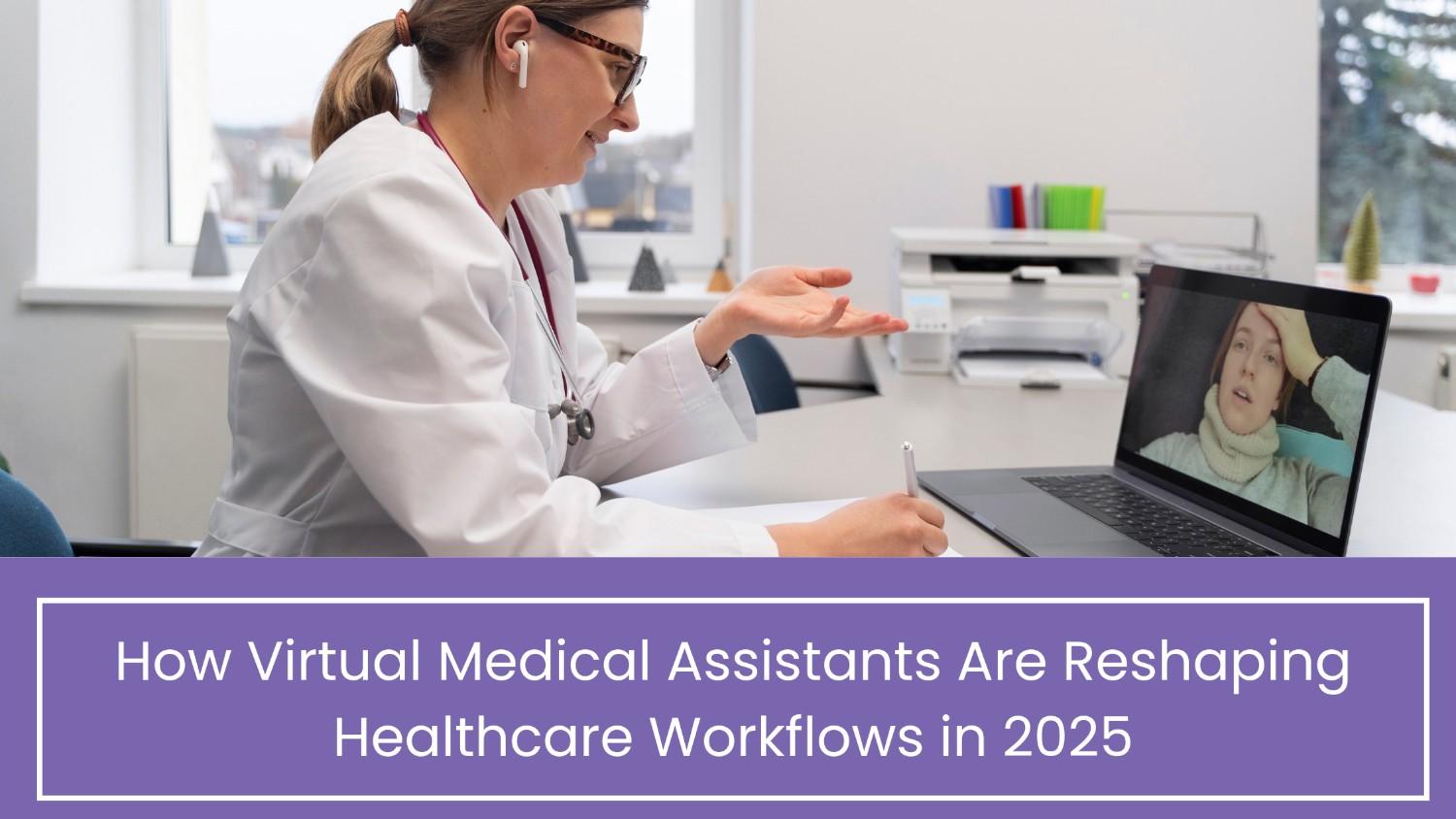How Virtual Medical Assistants Are Reshaping Healthcare Workflows in 2025
How Virtual medical assistants are reshaping healthcare workflows in 2025 by streamlining administrative tasks, enhancing patient communication, and improving efficiency across clinical operations. As AI and automation advance, healthcare providers are leveraging virtual assistants to reduce burnout, lower costs, and deliver better care—marking a pivotal shift in how modern healthcare functions.
By 2025, the health industry will have changed a lot. Experts like physicians, nurses, and clinic personnel are now balancing multiple tasks, such as patient care, administrative work, and time management.
Enter virtual medical assistants (VMAs), the unseen heroes of today’s healthcare. These clever solutions work from a distance, delivering vital support in many different areas of healthcare. VMAs are skilled at taking phone calls, processing payments, and processing documents. This support is priceless, as it enables medical staff to concentrate on the essence of their jobs: treating patients.
Let us move on to how VMAs affect healthcare operations and why each healthcare organization should consider implementing them.
Table of Contents
What Is a Virtual Medical Assistant?
A virtual medical assistant, or VMA, is a convenient tool that works remotely. They’re like having additional assistance for your virtual assistant for medical practice, but in a virtual format. Here’s what they can do for you:
- Arrange meetings with patients.
- Check if insurance covers the treatment.
- Reply to patient queries and messages.
- Take care of the money side of things with billing and medical coding.
- Keep all the patient’s information organized.
- Remind patients about their appointments.
VMAs are becoming a big deal in 2025 for a few key reasons:
- There aren’t enough people to go around for all the work in healthcare. A VMA doesn’t need a desk, so they’re a great solution to this problem.
- Doctors have a lot of paperwork these days, spending about 2 out of 5 hours on it. VMAs can lighten their load.
- New tech like smart chatbots, voice helpers, and safe ways to talk are making VMAs really good at their jobs and keeping everything safe.
So, VMAs are like having a helper that’s always there, but not in the physical sense. They use the latest tech to keep things running smoothly and help out when you need it most. It’s like having a super-efficient co-worker that doesn’t need a coffee break!
Key Benefits of Virtual Medical Assistants
Faster Meeting Set-up
VMAs are like digital assistants that handle your schedule. They book meetings, check everyone’s availability, and make sure you don’t forget with reminders. This means fewer no-shows and more organized days.
Fact to keep in mind: In 2024, offices using VMAs had a 22% reduction in missed appointments (HIMSS survey).
Enhanced Customer Service
VMAs are like having a 24/7 customer support team. They answer common queries through calls, emails, or live chat, keeping customers happy and your staff less stressed.
Trend to watch: By 2025, quick responses are the norm. VMAs are your ticket to meeting those high standards.
Improved Money Matters
VMAs help with the boring but important stuff like insurance and medical billing. They check details, sort out the paperwork, and chase payments faster.
Tip: In 2024, clinics saw a 30% faster payment thanks to VMAs in their revenue cycle management.
Assistance During Visits
Advanced VMAs are like having a second pair of hands for doctors. They update patient files, take notes, and get test results ready during appointments.
This means doctors can focus more on patients and have extra time for more appointments or well-deserved breaks.
Cutting Costs, Boosting Performance
Hiring extra staff can be pricey, with training and office space. VMAs are the cost-effective alternative that still gets the job done and improves how your business runs.
For instance, a small clinic saved as much as $50,000 a year by switching to VMAs.
VMAs are your business’s best buddy, making your job easier and your customers happier. They’re like having a team that never sleeps, always knows what to do, and saves you a ton of cash.
VMAs and AI: A Dynamic Duo for Business Success
By the year 2025, a large number of virtual medical assistants (VMAs) will be using artificial intelligence (AI). These smart tools are made to:
- Know what patients need before they say it, which helps in giving better service.
- Sort messages so the important ones are answered quickly.
- Handle following up with patients without humans needing to remember, which keeps patients happy.
- Find mistakes in medical records so things are right and don’t cost too much to fix.
These AI-based VMAs are not here to do humans’ work. They are here to work with healthcare staff and make everyone’s job easier.
Key Business Trends to Observe in 2025
- Doctor’s Voice Assistants for Efficiency – AI lets doctors give voice orders for notes and information during visits, making work smoother.
- Importance of Virtual Medical Assistants in Remote Work – VMAs are a big help as health offices go online.
- Keeping Patients Happy – Happy patients come back and tell others. VMAs are key for good talk and easy help.
- One Tool Does It All – Now, VMAs connect with patient records, billing, and more, making things less complicated.
These changes show AI is more and more a part of healthcare. It’s about making work better and keeping patients happy, all with a personal feel.
Challenges to Consider
While virtual medical assistants (VMAs) come with numerous advantages, it’s important for healthcare providers to:
- Select secure technology that safeguards patient information.
- Educate their team to efficiently use VMAs.
- Define everyone’s job duties clearly.
Positive Outcomes: Feedback from the Field
Healthcare professionals nationwide, including doctors and clinic managers, are noticing the following improvements with VMAs:
- They cut down on work stress.
- Administrative work gets done faster, saving over 10 hours weekly.
- Patients give better feedback.
- Insurance claims are processed quickly, leading to faster payments.
Testimonial from a Satisfied Client:
“Last year, we brought in two VMAs, and it was a game-changer. Our phone response time is much better, billing issues are resolved more smoothly, and I can finally manage my workload without feeling overwhelmed.” – Clinic Manager, California.
To get started, many health tech companies now provide a simple setup process, making it quick and painless even for smaller offices to integrate VMAs into their operations.
Practolytics: Your Reliable Practice Ally in the Future
Running a bustling practice in 2025 doesn’t have to be a headache—you’ve got Practolytics on your side.
We give you virtual medical assistants (VMAs) who are pros at handling your practice’s day-to-day, from booking appointments to sorting out bills and keeping everything up to code.
Here’s the deal:
- Skilled VMA squads: These folks know your field inside out.
- Speedy payments: No more waiting games with claims.
- Tailored reports: Get the lowdown on your practice’s performance.
- Secure systems: Protecting patient info is job number one.
- Around-the-clock help: We’re like your 24/7 business wingman.
Practolytics isn’t just an extra hand; we’re your full-fledged healthcare operations buddy.
Why not join the crowd?
Let’s be real — you should be with patients, not wrestling with paperwork. VMAs are the new normal in healthcare productivity.
Hundreds of providers are already on board.
Give us a shout today and find out how our VMAs can help you work smarter, feel less stressed, and boost your practice’s growth in 2025.
Read More – From Chaos to Efficiency: A Small Practice’s Journey with a Virtual Assistant






